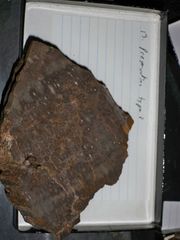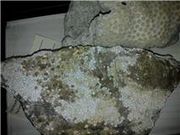Permineralization
Permineralization preserves fossil specimens by the infiltration of minerals in solution and subsequent precipitation of these minerals into open pore spaces. This often happens with fossilized wood and bones. Much of the original organic materials remain, but are surrounded by, and protected by the precipitants. The precipitated minerals can also undergo recrystallization as the specimen ages. This is one of many forms of diagenesis that can occur to a fossil specimen. A link is provided for viewing pictures of permineralized fossil specimens. http://petrifiedwoodmuseum.org/Permineralization.htm
This image of permineralized wood is typical of this type of preservation. A reliable identification tool for permineralization is the recognition of a known mineral embedded within material that has properties unlike the crystallized minerals within. There is a distinct difference in color in this specimen's organic remains, and the inorganic minerals. Close examination of the image reveals much detail of the original plant.
A good website with a lot of different pictures of petrified wood is http://petrifiedwoodmuseum.org/Permineralization.htm
http://oi53.tinypic.com/a3msld.jpg
Here's a picture of a fossil that has been permineralized, recrystallized, and replaced in places. You can tell it's perminerallized because you can see the internal molds formed by the minerals, most likely carried there by water travel.

